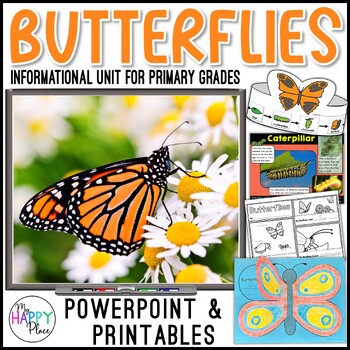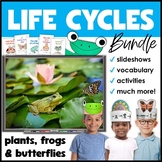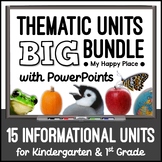Butterfly Unit – All About Butterflies Slideshow – Life Cycle Activities
- Zip
What educators are saying
Also included in
- This bundle of spring life cycle units is packed with engaging activities sure to spark your students’ curiosity and fill their days with active learning. The three engaging themes (All About Frogs, All About Butterflies, and All About Plants) in this bundle provide primary students with the interesPrice $16.20Original Price $22.50Save $6.30
- Keep your students excited about learning all year long with these informational thematic units for kindergarten and first grade! Each of the 15 units in this set includes a nonfiction PowerPoint slideshow full of eye-catching photos and clear informational text. In addition, with each theme comes aPrice $62.00Original Price $94.75Save $32.75
Description
This butterfly unit is packed full of insect learning and fun! Complete with an informational “All About Butterflies” PowerPoint, a butterfly craft, a hat/crown, and lots of printable materials, this set will turn your students into little entomologists. With eye-catching display materials including headers for three anchor charts along with colorful vocabulary word posters and word wall cards, children will have what they need to read, talk, and write about butterflies. This unit teaches students about the butterfly life cycle, parts of a butterfly, interesting features of butterflies, and more!
This informational butterfly unit is also included in this Thematic Units BIG Bundle and in this Life Cycles Bundle.
What’s included in this butterfly unit?
This “All About Butterflies” thematic unit includes materials to help you integrate learning about butterflies into science, social studies, literacy, and math in your primary classroom. You will download a zipped folder including a PPT file and a PDF.
Here’s what’s included:
✔ Informational PowerPoint Slideshow “All About Butterflies”
This slideshow is packed full of information about butterflies. Filled with clear photographs, this presentation includes nonfiction text about butterflies’ classification as insects, the habitat and diet of butterflies, their habits, life cycle, characteristics, and more. This PowerPoint slideshow is 20 slides long and is copied at the end of the PDF in addition to the PPT file (for those without access to PowerPoint).
✔ Butterfly Vocabulary Word Posters and Word Wall Cards
The included butterfly vocabulary word posters, each with a photo and a simple definition are: insect, metamorphosis, oviparous, caterpillar, pupa, chrysalis, butterfly, symmetrical, host plant, nectar, exoskeleton, molt, and camouflage. The word wall cards, each with a photograph, are: eggs, caterpillar, chrysalis, butterfly, leaf, flower, insects, garden, and plant.
✔ Anchor Chart Materials and Posters
Printable materials are included to help you create meaningful butterfly anchor charts with your students. You’ll find what you need to make a Butterflies KWL chart, a “Can, Have, Are” chart, and a “Butterfly Features” comprehension chart (pocket chart activity). In addition, this set includes a “Parts of a Butterfly” poster, a “Butterfly Life Cycle” poster, a butterflies/moths comparison chart, and an illustrated song and poem to display.
✔ Printable Butterfly Activities
▶ Themed Informational Writing Materials: In addition to writing organizers, this set includes various butterfly-themed lined writing sheets, a Can/Have/Are book template, and scaffolded writing templates.
▶ Butterfly Science Activities: Students cut and glue to complete these life cycle and parts of a butterfly worksheets. This section also includes a “Butterfly Symmetry” worksheet and life cycle-themed writing paper.
▶ Cut and Fold Butterfly Book: This informational easy reader is designed to be printed double-sided, using only one sheet of paper. Students can color the pictures, then practice reading and print concepts. This book has one simple sentence per page.
▶ Butterfly Writing Craft: This craft allows children to write four simple sentences about butterflies and create a lift-the-flap poster. Visual directions are included.
▶ Butterfly Life Cycle Crown: Use a sentence strip to complete this simple hat that has children cut and glue the butterfly life cycle in order. This cute crown is a great culminating activity for your butterfly unit. Visual directions are included.
▶ Thematic Printables: This section includes a selection of reading and math skill worksheets with a butterfly theme. It also includes butterfly-themed math playing cards and tips for using them in a few different ways.
How do I use this All About Butterflies unit?
Begin by accessing students’ background knowledge about butterflies by having a class discussion. As you discuss, fill in the “K” (What I Know) and “W” (What I Want to Know) columns of the KWL chart. Follow up with the PowerPoint slideshow, which can be read aloud in one sitting or can be used across several days. Young children will need time to discuss the information as it is presented, so be sure to build in time for conversations and questions! Upon completion of the PowerPoint (or as you go along), have students help fill in the final column of the KWL chart.
To guide students toward informational writing about butterflies, begin with the “Can, Have, Are” chart, having the students help determine what you should write in each section (a sample chart is included). Students can then begin to work on their own organizers which will scaffold them toward writing three informational sentences about butterflies. The Can/Have/Are book template, which is included in three levels of difficulty, is a great way for students to showcase their writing skills.
The “Butterfly Features” chart and the accompanying writing template help students build comprehension. These cards can be used in a pocket chart as whole group comprehension activity. Add sentence cards to the chart while reading the PowerPoint. Have students help select the photo that best supports the sentence. Students can use the follow-up writing page to draw and write about an interesting feature of butterflies.
The original butterfly song (to be sung to the tune of “Twinkle, Twinkle, Little Star”) and the butterfly poem help students remember facts about butterflies while also working on memorization and rhyme concepts. Consider having students come up with hand motions to go along with the song. Students can sing the song and recite the poem while wearing their hats! A cut-and-glue comprehension sheet accompanies the poem.
The thematic activities can be completed in any order (and you can pick and choose based on the needs and levels of your students).
Have students make butterfly life cycle hats to culminate their studies and encourage them to share butterfly facts with anyone who asks about their hat!
This informational butterfly unit is also included in this Thematic Units BIG Bundle and in this Life Cycles Bundle.
What Teachers Are Saying about “All About Butterflies”:
⭐⭐⭐⭐⭐ “You honestly can't go wrong with these science units with PowerPoints. I think I own them all now! My kiddos love them, and you have jam-packed them with amazing information. Love them all! Well worth the money!” — Katharine B.
⭐⭐⭐⭐⭐ “This is a great unit on butterflies! I love the PowerPoint presentation! All components are so well done, visually appealing, and complete! Thank you!” — Lisa E.
⭐⭐⭐⭐⭐ “Kids loved the PowerPoint so much, I had to split it into two sessions because they had so many observations and questions about the pictures. Thank you!” — Meaghan S.
⭐⭐⭐⭐⭐ “A perfect match to my butterfly unit! By the end of the week my students were using scientific terms! Crazy how much they pick up on :)” — Hannah S.
You may also like:
▶ Butterflies for Google Slides and Seesaw
▶ Pond Life Unit
▶ All About Frogs Unit
▶ Fine Motor Activities for Spring
Please see the preview file for more detailed images. If you have any questions, email susan@myhappyplaceteaching.com or use the “Q&A” feature on this page.
I would love to have you as a follower! Click the green star to be the first to know about new resources.
Thank you for shopping!
Susan Jennings (My Happy Place)
Copyright © My Happy Place Teaching Resources
Permission to copy for single classroom use only.
Please purchase additional licenses if you intend to share this product.







